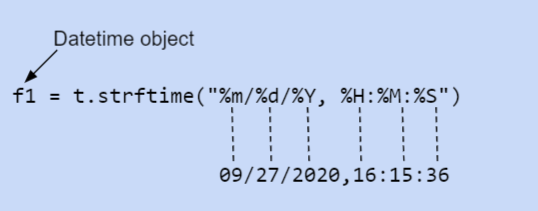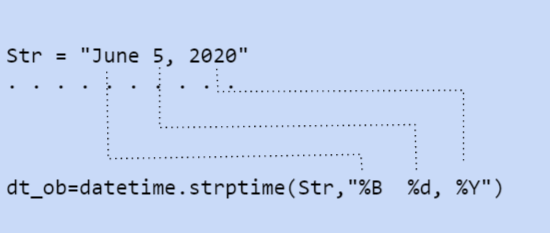


In this tutorial you will master to handle the date and time in python with the help of examples. You will walk through different modules used to manipulate date and time ,how to read and print time in a specific format ,etc.
Before digging deep into working of date and time let's walk through some old days to know about how computers count the time. Pointing to the fact, almost all computers are counting time based on Unix Epoch time which is 00:00:00 UTC on 1 January 1970.UTC (Coordinated Universal Time ), often known as GMT( Greenwich Mean Time) refers to the time of longitude at 0°.
Like other programming languages ,python too embraces the Unix Time concept whose standard library comprises a popular module named time. The time module got a function called time() which outputs the number of seconds since the unix epoch time.
>>> import time
>>> time.time()
1599329118.616698
This Unix time representation is incredibly difficult for humans to parse,hence it needs another way to convey the time to users. It can be accomplished by converting the Unix time to UTC which again converts to local time with the help of time zone offsets.the database of all values for the timezone offset is maintained by the Internet Assigned Numbers Authority in short known as IANA.
Since it was difficult for humans to determine the time in seconds, the time format was calculated in terms of years ,months,days, hours and so on. The world we live in is filled with diversity in every aspect like geographically , linguistically , culturally etc. so it became a necessity to standardize the time format to steer clear of all unnecessary complexity and communication mistakes. The International Organisation for Standard brings up ISO -8601 which specifies the date format should be in the order of most significant to least significant data. To be clear the standardized date format is as follows:
YYYY-MM-DD HH:MM:SS
Where YYYY denotes the year in four digit ,MM and DD gives the two digit representation of Month and Day. Similarly HH,MM and SS represents the two digit form of hours, minutes and seconds.
The key benefit of this is to avoid the ambiguity of date formats. For instance MM-DD-YYYY or DD-MM-YYYY oftenly misinterpreted when the value of month is a valid number.
Python offers three distinct modules to work with Date and Time . They are listed as follows:
Let’s start our learning with module datetime which helps to manipulate both date and time in python.
Get the minimum and maximum year represented in a system can be exported using the two constants MINYEAR and MAXYEAR in the datetime module.
The MINYEAR returns the smallest year number allowed in date and datetime objects, which is 1 while the MAXYEAR gives the largest year number representation permitted in date and datetime objects which is 9999.
import datetime
#constants in datetime Module
import datetime
print(datetime.MINYEAR)
print(datetime.MAXYEAR)
1 9999
To manipulate the date and time , Python datetime module contains the following classes which are tabulated here.
| Class | Returns or Description | Attributes |
|---|---|---|
| datetime.date | An idealized date | Year, month and day |
| datetime.time | An idealized time | Hour,minute,second, microseconds and tzinfo |
| datetime.datetime | Date and time combination | Year,month,day,hour, Minute,seconds, microseconds and tzinfo |
| datetime.timedelta | Duration between two instances | Weeks,days,hours,minutes,seconds,microseconds, milliseconds, |
| datetime.tzinfo | Timezone information | Nil |
| datetime.timezone | Implements tzinfo abstract base class | Nil |
The objects of classes date,time,datetime and timezone are immutable and hence hashable. So these objects can be used as a key for a dictionary.
Date objects in python work with dates in an idealized Gerogian calendar. It represents a date in the standard form YYYY-MM-DD.
datetime.date(year,month,day)
Here the arguments are must and should be an integer with their stipulated ranges as follows:
If any of the arguments failed to meet these range specifications ,then it encounters a ValueError.
The method today() is used to get the current local date.In this example we have imported the module datetime and we have created an object d_ob for the class datetime.date which calls the method today().
import datetime
#Current date
d_ob = datetime.date.today()
print(d_ob)
2020-09-06
The result provides you the current local date.
Unix timestamp is the time represented in the number of seconds between a specific date and January 1, 1970.for instance 1599468233 is a timestamp. It is possible to convert a timestamp to actual date with the help of a method called fromtimestamp().
from datetime import date
ts = date.fromtimestamp(1599468233)
print('Date from Timestamp is',ts)
Date from Timestamp is 2020-09-07
A date given in the form of string can be converted into standard format using the method fromisoformat(). This is a pretty cool method which always outputs the date in the format YYYY-MM-DD.
from datetime import date
str = date.fromisoformat('2020-02-14')
print(str)
2020-02-14
The method fromisocalendar gives you the date when year ,week and day is passed as the argument .
from datetime import date
cal_date = date.fromisocalendar(year=2020,week=20,day=5)
print(cal_date)
2020-05-15
Now suppose if you want to get the current date along with time you can use the other class in the datetime module which is datetime.datetime.A datetime object is an individual object which works with date object and time object.
datetime.datetime(year,month,day,hour=0,minute = 0,sec = 0,tzinfo = None)
The commonly used methods are listed below :
import datetime
#Current date
dt_ob = datetime.datetime.now()
print(dt_ob)
2020-09-06 15:39:27.272038
import datetime
#Current date
dt_ob = datetime.datetime.today()
print(dt_ob)
2020-09-06 15:39:27.272038
You can also instantiate the datetime classes by passing keyword arguments as given in the example: The only difference is that here we are not invoking any specific methods rather we provide the date and time.
from datetime import datetime
dt_ob3 = datetime(year = 2020,m = 29,hour = 6,minute = 30,sec
print(dt_ob3)
2020-10-29 06:30:45
It is also possible to retrieve individual entities like year alone or month alone or hour alone. This can be accomplished with dot notation.
from datetime import datetime
dt_ob = datetime(year = 2020,m = 29,hour = 6,minute = 30,sec
print('Current Year is',dt_ob.year)
print('Current time is ',dt_ob.hour)
print('Timestamp of the date is',dt_ob.timestamp())
Current Year is 2020 Current Minute is 6 Timestamp of the date is 1603938645.0
from datetime import datetime
ts = datetime.fromtimestamp(1599468233)
print('Date from Timestamp is',ts)
Date from Timestamp is 2020-09-07 12:43:53
Timedelta class is a class commonly used in datetime modules along with aforementioned classes to find the difference of two dates or time i.e the duration. In the following example we have created two date objects d1 and d2 and their difference is stored in d3. Here, d3 belongs to the timedelta class. Similarly the difference of two datetime objects gives you a timedelta object.
from datetime import date,time,datetime
from datetime import date,time,datetime
d1= date(2020,9,2)
d2=date(2019,9,7)
d3 =d1-d2
print('Difference is ',d3)
print("Type is ",type(d3))
t1=datetime(2020,9,2,11,45,30)
t2=datetime(2018,9,7,10,50,40)
print('time Difference is ',(t1-t2))
Output:
Difference is 361 days, 0:00:00 Type is <class 'datetime.timedelta'> time Difference is 726 days, 0:54:50
To manipulate timedelta objects we initially need to import the timedelta class from the datetime module.
#timedelta objects difference
from datetime import timedelta
td1 = timedelta(weeks=2,days=3)
td2 = timedelta(weeks=1,days=5)
td3 = td1-td2
print(td3)
5 days, 0:00:00
#timedelta objects difference
from datetime import timedelta td5 = timedelta(sec
td = timedelta(sec
td7 = td5-td6
print(td7)
print(abs(td7))
-1 day, 23:59:30
To get the timedelta objects in seconds we can use the method called total_seconds() which expresses duration in seconds.
from datetime import timedelta
td1 = timedelta(weeks=2,days=3)
print(td1.total_seconds())
1468800.0
We have discussed earlier that in different countries the format of date and time differ. For instance in the US the common date format they rely on is MM-DD-YYYY whereas in the UK the format is DD-MM-YYYY. This creates an ambiguity if the month is a valid number. So a measure to handle this ambiguity is required in python, so here comes the two formatting methods:
Strftime method() is a formatting method defined in all three classes(date,time,datetime) to represent a given date,time and datetime as readable string.it contains only one argument called format where we specify the format in which date is needed.
visualization below gives you better clarity on the concept.

from datetime import datetime
t = datetime.today()
print(t)
f1 = t.strftime("%m/%d/%Y, %H:%M:%S")
# MM/DD/YYYY H:M:S format
print("Format 1:", f1)
f2 = t.strftime("%d/%m/%Y, %H:%M:%S")
# DD/MM/YYYY H:M:S format
print("Format 2:", f2)
Output:
2020-09-27 16:15:36.913768 Format 1: 09/27/2020, 16:15:36 Format 2: 27/09/2020, 16:15:36
This is another formatting method which is supported by datetime objects only and is just the opposite of strftime() method. Here the datetime object gets created from the given string. And it contains two arguments
On the basis of the above two arguments it produces a datetime object as the result. The following visualization clears the idea.

from datetime import datetime
Str = "June 5,2020"
print(Str)
dt_ob=datetime.strptime(Str,"%B %d,%Y")
print(dt_ob)
Output:
June 5,2020 2020-06-05 00:00:00
When the string and the format code passed to the strptime() method does not match, python will raise a ValueError For instance,
from datetime import datetime
Str = "June 5,2020"
dt_ob=datetime.strptime(Str,"%d %B ,%Y")
print(dt_ob)
Output:
ValueError: time data 'June 5,2020' does not match format '%d %B ,%Y'
| Directive | Meaning | Example |
|---|---|---|
| %a | Abbreviated version of weekdays. | Sun, Mon, …, Sat |
| %A | Complete version of weekdays. | Sunday, Monday, …, Saturday |
| %w | Weekday as a decimal number, where 0 is Sunday ,1 is Monday and 6 is Saturday. | 0, 1, …, 6 |
| %d | Day of the month as a zero-padded decimal number. | 01, 02, …, 31 |
| %b | Abbreviated version of month | Jan, Feb, …, Dec |
| %B | Complete version of month | January, February, …, December |
| %m | Month as a zero-padded decimal number. | 01, 02, …, 12 |
| %y | Short version of year excluding century | 00, 01, …, 99 |
| %Y | Full version of year including century | 0001, 0002, …, 2013, 2014, …, 9998, 9999 |
| %H | Hour as a zero-padded decimal number.- 24 hour | 00, 01, …, 23 |
| %I | Hour as a zero-padded decimal number- 12 hour | 01, 02, …, 12 |
| %p | AM or PM. | AM, PM |
| %M | Minute as a zero-padded decimal number. | 00, 01, …, 59 |
| %S | Second as a zero-padded decimal number. | 00, 01, …, 59 |
| %f | Microsecond as a decimal number, zero-padded on the left. | 000000, 000001, …, 999999 |
| %z | UTC offset in the form ±HHMM[SS[.ffffff]] | (empty), +0000, -0400, +1030, +063415, -030712.345216 |
| %Z | Time zone name | (empty), UTC, EST, CST |
| %j | Day of the year as a zero-padded decimal number. | 001, 002, …, 366 |
| %U | Week number of the year (Sunday as the first day of the week) as a zero padded decimal number. | 00, 01, …, 53 |
| %W | Week number of the year (Monday as the first day of the week) as a decimal number. | 00, 01, …, 53 |
| %c | date and time local representation. | Tue Aug 16 21:30:00 1988 |
| %x | Date local representation. | 08/16/88 (None);08/16/1988 (en_US) |
| %X | Time local representation. | 21:30:00 |
| %% | A literal '%' character. | % |